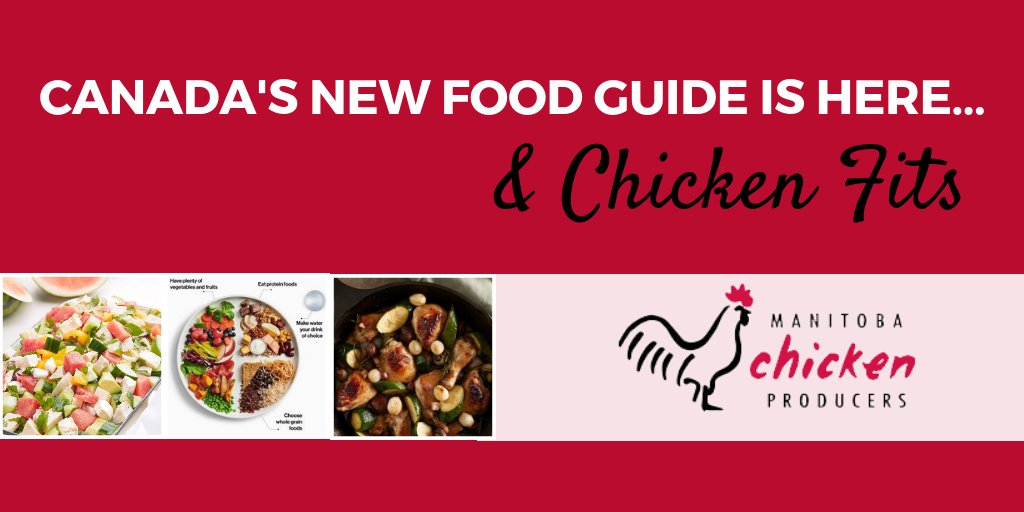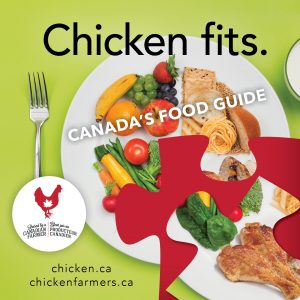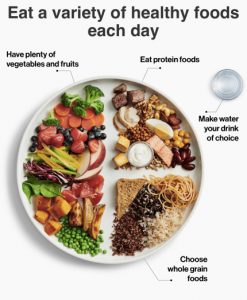Canada’s new Food Guide is here! It’s exciting to see images of real food with easy to understand recommendations. In its new guide Health Canada encourages Canadians to eat healthy, whole foods, in the correct proportions as the dietary foundation for good health. This includes eating more vegetables and fruits, protein-rich food (chicken, other meats, fish, along with dairy and plant proteins such as pulses, nuts, seeds and tofu) and whole grains. The guide also provides a variety of online resources to help guide healthy eating. If you haven’t seen the new food guide yet or accompanying resources, you can view them here: Food Guide and Healthy Eating Resources.
It’s about proportions and not portions (or numbers of servings).
The first page is a pleasing image of a plate with images of real foods, depicting a greater variety of foods than in previous guides. The food photos also visually help us in selecting healthy food choices.
It serves Canadians uncomplicated, key recommendations for optimal health.
- Eat a variety of healthy foods each day
- Have plenty of vegetables and fruits
- Choose whole grain foods
- Eat protein foods
- Make water your drink of choice
The title delivers a bold key message: Eat well (to) Live well.
When a title can deliver such a strong key message it will be difficult for Canadians to ignore. Simply put, making nutritious food choices is a foundation for good health!
It not just what you eat, but is it also about how you eat!
It’s food guide delivers more than just advice about food choices to Canadians. Page two of the guide informs us healthy eating is more than just about the food choices you make, it’s also about how to eat and recommends taking these key factors into consideration:
- Be mindful of your eating habits
- Enjoy your food
- Eat meals with others
- Use food labels
- Limit foods high in sodium, sugars or saturated fat
- Be aware of food marketing
- Cook more often
Cooking more often and enjoying food with others are important messages for how to eat! Preparing food, using nutritious ingredients is economical and a practical way to improve eating habits. To help you cook more often here are some terrific recipes that incorporate protein-rich chicken, vegetables, fruits and whole grains:
Chicken Melon and Avocado Salad
Chicken Stir Fry with Water Chestnuts
Please check out the rest of our excellent recipes and Health Canada’s new recipe collection as well.
The food guide falls short on guiding Canadians on protein quality and quantity.
By creating a general protein grouping the guide falls short by not differentiating key nutritional attributes of animal versus plant protein. Grouping together chicken, meat, pulses, soy, nuts and seeds and dairy implies they deliver identical nutrition. This is a misconception. Plant sources of protein are generally inferior to animal sources of protein. The new protein group does not communicate this clearly to the public.
Using the guide’s plate proportion, a ¼ of-the-plate serving of chicken breast, about 100 grams, would provide about the same grams of protein (30 g) as about 350 grams of tofu. The proportion of most plant protein choices would actually fill your entire plate to obtain the same grams of protein as serving of meat, leaving little room for the other food choices.
To achieve the same amount of protein (30 grams) as found in one serving of 100 grams of cooked chicken breast you would need to consume:
- 350 g of tofu
- 700 g of quinoa
- 150 g of almonds (also delivering 2400 calories and 50 grams of fat)
- 390 g of cooked navy beans
- 350 g of cooked lentils
Nutrient values from: Health Canada, Canadian Nutrient File, 2018-02-06
But there is more to consider than just protein quantity. Protein quality is also important for health. Proteins are made of up different amino acids. The body can create some amino acids, but there are many essential amino acids that only come from food. You need a variety of amino acids for your body to function properly. Protein is needed for overall health and maintenance of the entire body. It provides the building blocks for every cell in the body including muscle, skin, hair and even bone. Protein is even important for healthy immune function.
Poultry, meat, fish and eggs are excellent sources of all of the essential amino acids. You can also get many of the necessary amino acids from plant sources like beans, soy, nuts and some grains, but they are not the same when it comes to protein quality. It’s important for Canadians to understand plant proteins and animal proteins are not created equally and cannot be interchanged with each other to obtain the same key nutrients. There are no plant proteins that contain the quality of protein provided in animal proteins and only animal-based food contain the key nutrient Vitamin B12, critical for healthy red blood cells. Also, the iron obtained from animal protein is more easily absorbed than the variety found in plants. Bottom line is, enjoy a wide variety of healthy foods everyday from both plant and animal sources!
At Manitoba Chicken we’d love to connect with you. Follow us on Facebook, Twitter, Instagram and You Tube at: @manitobachicken
Gina Sunderland, MSc, RD, Manitoba Chicken Producers Food & Consumer Relations Specialist dietitian
I enjoy engaging with consumers! If you have a question about how to cook with chicken, the nutritional attributes of chicken or chicken farming, I’d love to hear from you!
*Views expressed are my own.












